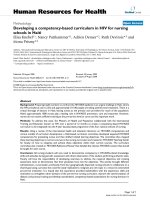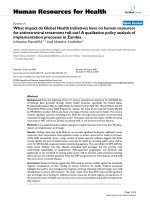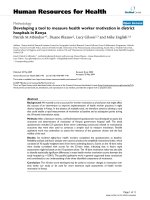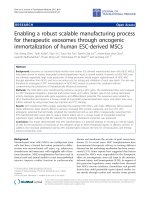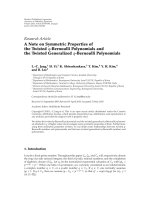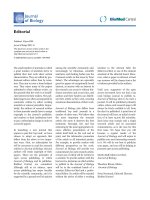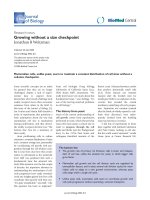Báo cáo sinh học: " Q&A: What did Charles Darwin prove" ppsx
Bạn đang xem bản rút gọn của tài liệu. Xem và tải ngay bản đầy đủ của tài liệu tại đây (98.7 KB, 3 trang )
Question & Answer
QQ&&AA:: WWhhaatt ddiidd CChhaarrlleess DDaarrwwiinn pprroovvee??
Paul Harvey
IItt iiss oofftteenn ssaaiidd tthhaatt DDaarrwwiinn’’ss
tthheeoorryy ooff nnaattuurraall sseelleeccttiioonn iiss
uunnpprroovveenn TTrruuee??
I don’t think that is a very useful
question because Darwin’s strength
comes not so much from what he
proved, but from the near-inescapable
conclusions that he led us to. He used
every means of informing himself
about questions that interested him.
He is known for his massive and
continuous correspondence, always
asking pertinent questions of those
studying what we should now call
model systems or model organisms.
Of course, he was also a great natural
historian himself, so his own obser-
vations pervade his writings. He was
then able to integrate observations
from one species into a prototype for
what we now call the comparative
method - he looked across species and
showed how similar environments
resulted in the development of similar
adaptations. When making cross-
species comparisons it is important to
distinguish between similarity through
inheritance from a common ancestor
and similarity through independent
evolutionary origins.
BBuutt iissnn’’tt tthhee ccoommppaarraattiivvee mmeetthhoodd
tthhaatt uusseess iinnffeerreennccee ffrroomm
iinnddeeppeennddeenntt eevvoolluuttiioonnaarryy oorriiggiinnss aa
rreecceenntt
ddeevveellooppmmeenntt??
Yes, many of us have made a big deal
of developing and applying new
statistical methods, but Darwin was
on to the problem. He just did not use
statistics and probabilities, which is
why I call his method a prototype. For
example, he noted that a higher
proportion of tree species compared
with other plants in Great Britain have
male and female flower structures on
separate plants. But he went further
and showed that this pattern of
predominance occurs within many
families of trees. Since there is variation
within the families, he knew he was
not dealing with a single evolutionary
event, with subsequent inheritance
from an ancestral tree species.
SSoo hhee wwaassnn’’tt aann eexxppeerriimmeennttaall
bbiioollooggiisstt??
Yes he was that too, and moreover he
was a remarkable one. There is no
doubt that some people have the
knack of designing simple experi-
ments that minimize the number of
alternative explanations for the results.
Darwin was one of those. For exam-
ple, it had been claimed that orchids
did not secrete nectar but that they
fooled insects into believing they did;
the conspicuous nectaries (Figure 1)
had no function except to deceive
insects into visiting the flower, which
thereby transferred its pollen. Darwin
simply cut off half the length of the
nectaries from some flowers on an
orchid head and found that they
tended not to get their pollen
removed. In another case, he was
interested in how carnivorous plants
differed in trapping their prey. Just
touching the surface filaments of a
Venus fly trap (Dionaea) with a
delicate human hair (perhaps from
one of his young children?) caused the
trap to rapidly close; no sticky, viscous
fluid was involved. In contrast, a thick
human hair (perhaps one plucked
from his beard?), dragged across a
sundew (Drosera; Figure 2) leaf surface
excited no movement in the plant, but
resistance from the sticky-surface fluid
was marked. Clearly, Venus fly traps
catch insect prey in the locked trap
while sundew glue them down before
digestion. Indeed, it is difficult to
understand how a person with
Darwin’s intellect missed observing
Mendelian segregation in his plant-
breeding experiments, but he did.
Journal of Biology
2009,
88::
11
Paul Harvey, Department of Zoology,
University of Oxford, The Tinbergen Building,
South Parks Road, Oxford OX1 3PS, UK.
Email:
FFiigguurree 11
The orchid
Angraecum sesquipedale
(also
called Darwin’s orchid, Christmas orchid, Star
of Bethlehem orchid, King of the Angraecums).
The nectary on this species of orchid is
25-30 centimeters (10-12 inches) long.
Photograph courtesy Umberto Paris.
AArree yyoouu ssaayyiinngg DDaarrwwiinn ccoouulldd bbee aa
rroollee mmooddeell ffoorr aa 2211sstt cceennttuurryy
sscciieennttiisstt??
If you mean by that: Did he pose the
same sort of questions in the same
way as contemporary biologists? -
then the answer is yes. Indeed, he set
the research agenda that many still
follow: as Dobzhansky famously put it
“nothing in Biology makes sense
except in the light of evolution”. That
implies that all research biologists are
following Darwin’s agenda! Of course,
he could not have known how to
pursue the great unknowns in genetics,
or how developmental biology would
be incorporated into mainstream evo-
lutionary theory (or what we now call
evo-devo). But he did frame many of
the unsolved questions for what we
would now call organismic biology. He
appreciated the importance of sexual
selection, that something generally
kept sex ratios around 50:50, that
altruism must evolve by some inter-
esting process, that distastefulness and
warning coloration (see Figure 3 for a
classic example) are in some sense
adaptations. He didn’t exactly know
how these things evolved, and even
explicitly left some problems to be
solved in the future (that is, he
admitted that he was stumped). So
along came RA Fisher, WD Hamilton
and a host of others who were able to
use algebra to identify what would
evolve as conditions changed. Given
that he wasn’t particularly numerate,
Darwin’s logic remains beautiful to
read. But, as a 21st-century scientist,
his correspondents would have inclu-
ded some theoreticians who could
better develop his ideas and force
him to state his assumptions with
greater clarity.
SSoo hhee wwaass ccoonnffuusseedd aabboouutt ssoommee
tthhiinnggss,, ddeessppiittee tthhee ggaarrggaannttuuaann
iinntteelllleecctt??
Yes, he was. But it has been pointed
out that it is better to get an approxi-
mate answer to the right question,
however vague, than the right answer
to the wrong question, which can
always be made more precise! Darwin
got the right questions, resulting in
the approximate answers. For exam-
ple, he realized the approximate conse-
quences of accepting blending inheri-
tance or the problems with accepting
group selection as a strong evolu-
tionary force. He was not to know that
blending inheritance did not occur or
that group selection could be
redefined as kin selection. If only the
advances in genetics had been made
in tandem with his work on evolution,
then the fog would have lifted.
BBuutt DDaarrwwiinn ddiiddnn’’tt ppuubblliisshh ppaappeerrss
lliikkee aa 2211sstt cceennttuurryy sscciieennttiisstt,, ddiidd
hhee??
I think the answer to that one has to
be a resounding no. One thing shines
out and that is Darwin’s appreciation
of the need to reflect at length. Indeed,
he went further and argued that his
career had taught him that there had
not been any instance when he had
regretted holding back on publication.
The published product, he argued, was
all the better for repeated polishing
and tinkering. That is virtually un-
thinkable nowadays, with so many
Wallace’s in the woodwork. The
balance has shifted increasingly
towards achieving priority. Neverthe-
less, I still find this a puzzle: how
could Darwin have felt so very secure?
WWhhaatt wwaass ssoo ssppeecciiaall aabboouutt
DDaarrwwiinn??
Several things. The fact that he kept at
his researches at a fairly even rate from
the voyage of the Beagle until his
death is one of them. There’s no doubt
in my mind that he could have kept
on going for another lifetime - once
you have set the conceptual foun-
dation as he did, then the world opens
up for you. New questions are around
every corner. That is pure joy. But the
other side of that is that Darwin didn’t
seem to age, in the sense that later in
life we generally try to fit new facts
into a world view that we developed
decades before; we build our own
phlogiston universes. We have to
remind ourselves that, while Darwin
was always learning, if he felt that a
gradual accumulation of facts ques-
tioned a treasured conclusion, then he
would revisit that conclusion and all
that resulted from it. His increasing
acceptance of blending inheritance
and its consequences, which I men-
tioned above, is a case in point. I
11.2
Journal of Biology
2009, Volume 8, Article 11 Harvey />Journal of Biology
2009,
88::
11
FFiigguurree 22
Drosera rotundifolia
, the original sundew
species studied by Charles Darwin.
Photograph by John Brittnacher, International
Carnivorous Plant Society; reproduced with
permission.
FFiigguurree 33
Monarch butterflies (
Danaus plexippus
) are
poisonous and distasteful; this is advertised to
potential predators by brightly colored wings.
Photograph by Derek Ramsey, reproduced
under GFDL 1.2 [ />Wikipedia:Text_of_the_GNU_Free_
Documentation_License].
could go on answering this question
because Darwin provided me with an
agenda at about the age of 15 and I’ve
been with it since. But, I’ll make a
final point - Darwin could write so
well. So well that he expresses himself
with enormous clarity across the
centuries. Any of us can pick up one of
his books and read it with ease and for
pleasure. And we’ll fairly rapidly find
places where Darwin’s clarity of style
reveals errors of logic, and whether
those are because we have learned
more in the years since he wrote or
because he made some obvious
mistakes is for us his readers to decide.
If we are up to it.
Published: 23 February 2009
Journal of Biology
2009,
88::
11
(doi:10.1186/jbiol118)
The electronic version of this article is the
complete one and can be found online at
/>© 2009 BioMed Central Ltd
/>Journal of Biology
2009, Volume 8, Article 11 Harvey 11.3
Journal of Biology
2009,
88::
11
